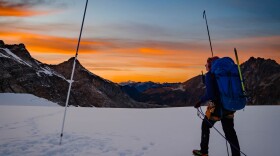-
(Runtime 1:00)Fresh white powder falling onto Northwest mountaintops last month created the perfect conditions for several ski resorts to open early this…
-
(Runtime 1:04)Snow-covered undulating trails will stretch out in front of hundreds of cross country skiers as they line up at the start of the multisport…
-
(Runtime :58)The snowpack in Idaho is lower than it has been in decades. Officials in Idaho are worried another hot summer is on the horizon, said Erin…
-
(Runtime 1:06)New tools are allowing scientists to measure snowpack with lasers from space.“Now we have this capability to measure snow from space. And…
-
(Runtime 1:03)For mountain snowpack to melt slowly, not all of the white fluffy stuff is created equally. Northwest scientists have found reducing…
-
With about a month left in winter, Washington’s mountain snowpack is close to or above normal levels. Idaho’s situation is a mixed bag.
-
For much of the Northwest, snowpack is above normal. That’s a good sign this time of year, when snowpack usually reaches its peak. Having enough snowpack is critical for spring and summer runoff that will supply water for irrigation and salmon runs. But that doesn’t mean everywhere has that much snow.
-
At the start of 2020, the situation looked dismal. After a dry start to the season, Washington and Oregon had less than half the amount of snow they’d normally see in the mountains. Then came the first few weeks of January.
-
New research says climate change is decreasing the amount of snow in the Pacific Northwest. And that has implications for water resources in the region.
-
All this snow so late in the season prompts the much-asked question: Is this climate change? Kathie Dello, a climatologist with Oregon State University in Corvallis, says this late-winter snow is perfectly normal. But, it doesn’t mean the larger picture is all fine.
Play Live Radio
Next Up:
0:00
0:00
Available On Air Stations










